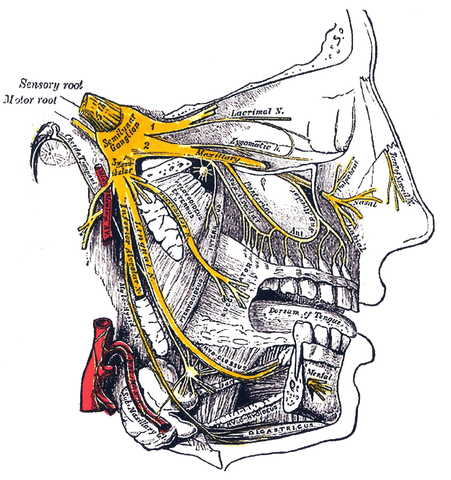Ice Scream
“Sphenopalatine ganglioneuralgia” sounds like a terrible disease, and, certainly, it can be painful. But for most of us, sphenopalatine ganglioneuralgia is a punishment worthy of the crime — the crime of eating ice cream. Sphenopalatine ganglioneuralgia is the affliction better known as “brain freeze” or “ice cream headache,” the stinging sensation one feels at the top/front of his or her head after eating too much ice cream too quickly.
Many of us have experienced it — one study (yes, there’s a study on ice cream headaches) suggests as many as one third of the population has been so afflicted. But why does it happen? The most common explanation suggests that, in a sense, brain freezes are caused by our brains malfunctioning.

Our faces have a nerve called the trigeminal nerve (depicted above in yellow) which contains three parts. One of the three parts carries sensory information from our foreheads to our brains while another one does the same for the roof of our mouths. (The third one focuses on the lower mouth, but that’s not relevant to conversations about ice cream headaches.) Eatingice cream causes the blood vessels in our face to contract quickly and, when the ice cream leaves our mouths, those same blood vessels get warm and dilate, or expand. If we eat the ice cream too quickly, the blood vessels expand rapidly, and that’s where the trigeminal nerve takes over. The part of the nerve in the roof of the mouth sends a signal to our brains, telling the brain that something’s wrong.
And the brain screws it up. This “mistake” is a phenomenon called “referred pain,” where the brain misplaces the source of the sensation. It’s not very common, although it’s also seen in heart attacks, where the brain will often incorrectly place the pain in the shoulder instead of the chest. In the case of brain freeze, instead of “understanding” the signal for what it is — a change in temperature in our mouths — our brains instead think that the signal is coming from the forehead. The brain reacts by turning that signal into a migraine-like headache, although a short-lived one, thankfully.
Why this referred pain phenomenon occurs is unknown. But we do know that if you do not want to experience it, there’s an easy solution: slow down when you’re eating a frosted treat.
Bonus fact: The world’s largest ice cream manufacturer and distributor is Unilever. They own Breyer’s, Ben and Jerry’s, Klondike, Good Humor, Popsicle, and … Slim Fast.
From the Archives: Ice Cream, You Scream: Another way ice cream can cause pain, in a much more sinister fashion.
Related: A ten pack of Astronaut Ice Cream. It’s not cold, so no brain freeze!
